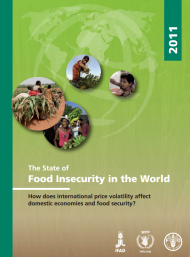
The State of Food Insecurity in the World

Abstract
The State of Food Insecurity in the World 2011 highlights the differential impacts that the world food crisis of 2006-08 had on different countries, with the poorest being most affected. While some large countries were able to deal with the worst of the crisis, people in many small import-dependent countries experienced large price increases that, even when only temporary, can have permanent effects on their future earnings capacity and ability to escape poverty.
This year’s report focuses on the costs of food price volatility, as well as the dangers and opportunities presented by high food prices. Climate change and an increased frequency of weather shocks, increased linkages between energy and agricultural markets due to growing demand for biofuels, and increased financialization of food and agricultural commodities all suggest that price volatility is here to stay. The report describes the effects of price volatility on food security and presents policy options to reduce volatility in a cost-effective manner and to manage it when it cannot be avoided. It will be important to provide improved market information, create gender-sensitive safety nets that are designed in advance and can be implemented quickly in times of crisis, and invest in agriculture for the long-term to make it more productive and resilient to shocks.
- Issue:
- Natural Resources
- Region:
- Global
- Year Published:
- 2011
- Institutions:
- International Fund for Agricultural Development (IFAD), World Food Programme (WFP), Food and Agriculture Organization (FAO), United Nations

